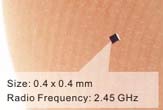Scary Small: New Tracking Chip Size of a Dust Grain

The world's smallest and thinnest RFID tags were introduced Tuesday by Hitachi. Tiny miracles of miniaturization, these RFID chips (Radio Frequency IDentification chips) measure just 0.05 x 0.05 millimeters. "RFID" refers to small electronic devices that use a tiny antenna to transfer small amounts of data for identification purposes.
The previous record-holder, the Hitachi mu-chip, is just 0.4 x 0.4 millimeters. The mu-chip RFID tag looks like a speck of dust on a human fingertip. The "powder type" tags are some sixty times smaller, barely noticeable next to a human hair (powder RFID).
The new tag compared to a fingertip (left) and in use on a gift certificate. Credit: Hitachi
The new RFID chips have a 128-bit ROM for storing a unique 38 digit number, like their predecessor. Hitachi used semiconductor miniaturization technology and electron beams to write data on the chip substrates to achieve the new, smaller size.
Hitachi's mu-chips are already in production; they were used to prevent ticket forgery at last year's Aichi international technology exposition. RFID 'powder,' on the other hand, is so much smaller that it can easily be incorporated into thin paper, like that used in paper currency and gift certificates.
Science fiction fans will have a field day with this new technology. In his 1998 novel Distraction, Bruce Sterling referred to bugged money:
They always played poker with European cash. There was American cash around, flimsy plastic stuff, but most people wouldn't take American cash anymore. It was hard to take American cash seriously when it was no longer convertible outside U.S. borders. Besides, all the bigger bills were bugged. (Read more about bugged money)
These tiny RFID tags could be worked into any product; combined with RFID readers built into doorways, theft of consumer goods would be practically impossible.
These devices could also be used to identify and track people. For example, suppose you participated in some sort of protest or other organized activity. If police agencies sprinkled these tags around, every individual could be tracked and later identified at leisure, with powerful enough tag scanners.
Sign up for the Live Science daily newsletter now
Get the world’s most fascinating discoveries delivered straight to your inbox.
To put it in the context of popular culture, you may recall the following scene from the 1996 movie Mission Impossible. One of the IMF operatives places a tracking tag on the shoulder of a computer programmer. Pretty clunky-looking tag (see photo from movie).
Take a look at these earlier stories related to RFID, and consider how much easier it will be with tinier chips: RFID Sensor Tag Shower For Disasters (gentle rain of RFID), RFID-Maki: Easy Payment Sushi (just tag the sushi directly, then scan customer's stomach [no joke, see digestible tags]) and VeriChip Chairman Proposes RFID Chips For Immigrants (just dust the border).
Via Pink Tentacle.
(This Science Fiction in the News story used with permission from Technovelgy.com - where science meets fiction.)
'Secrets of the Penguins' will take penguin observations 'to another level,' executive producer James Cameron
Curiosity rover finds largest carbon chains on Mars from 3.7-billion-year-old rock
Stabbed, cut, attacked, twisted — scientists subject new stretchable battery to extreme torture, and it retained 90% of its capacity









